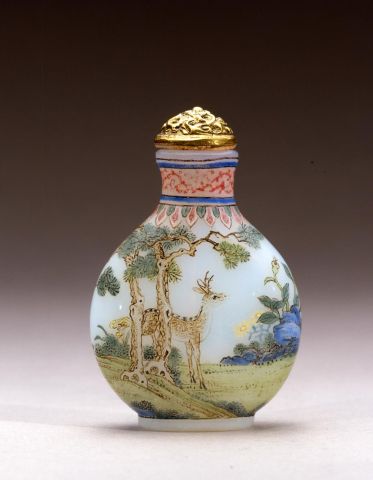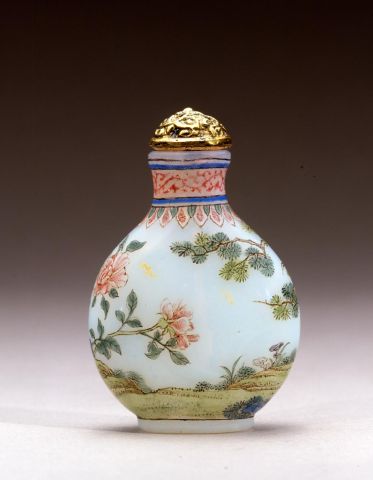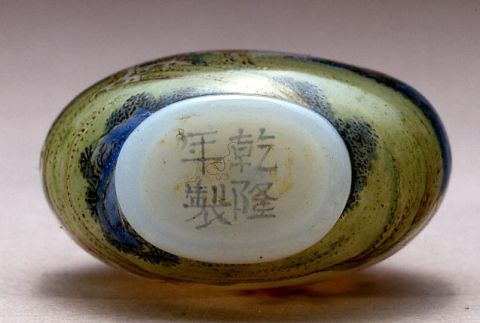


Bottle ID: 00189
WHITE, FAMILLE ROSE, DEER & BATS IN PINE TREE LANDSCAPE
Date: 1736-1795
Height: 49 mm
Glass, of rounded form with shoulders tapering to a slightly everted mouth, and with a neatly carved footrim, decorated in famille rose enamels with on one side, a deer stepping out from a copse of pine trees by lingzhi fungus on a grassy bank beside a rocky outcrop of flowers; the reverse with two bats flying toward peonies by a pine tree above lingzhi fungus; below a scrolling band with a petal lappet at the neck and shoulders; the base with a blue enamel four character Qianlong nian zhi mark in regular script, and of the period.
Imperial, attributed to the Palace Workshops, Beijing.
Similar Examples:
Crane Collection no. 148.
Kleiner, Robert. Chinese Snuff Bottles in the Collection of Mary and George Bloch, 1995, pp. 54-55, no. 27.
Stevens, Bob C. Collector's Book of Snuff Bottles, 1976, p. 267, no. 951; and p. 284, no. 1031.
Provenance:
Clare Lawrence Ltd.
Joseph Baruch Silver
Sotheby's, New York, November 22, 1988, lot 26
The Bai Shi Collection [Karel Bass]
Sotheby's, New York, April 16, 1985, lot 79
Alice B. McReynolds
Count Kurt Blucher Von Wahlstatt
Exhibited:
Annual Convention ICSBS Toronto, October 2007
Published:
JICSBS, Winter 2008, p. 6, figs. 4a and 4b
Lawrence, Clare. Twenty-Five Eminent Chinese of the Ch'ing Period, 1993
Lawrence, Clare. 1993 Chinese Snuff Bottle Engagement Diary, 1992
JICSBS, Autumn 1985, p. 135, fig.2
JICSBS, September 1975, front cover
Moss, Hugh. Snuff Bottles of China, 1971, p. 121, no. 270
Moss, Hugh M. Ltd. An Exhibition of Chinese Snuff Bottles, London, June 1970, p. 66, no. 263
This is one of the most beautiful and intriguing of enameled glass snuff bottles. Its sheer quality alone raises it above other enameled glass bottles in The Crane Collection. The subject matter of a deer under pine, while highly symbolic and not unusual elsewhere, is rare on enameled wares emanating from the Court where more formal designs were normal.
The Archives of the Imperial Household Department state that on the 29th day of the ninth month in 1740 (the sixth year of Qianlong), snuff bottles made of enamel on copper, glass, jade, amber and gold-flecked glass, totaling sixty-three items bearing Qianlong marks, were put in miniature drawers within a lacquer box for safe-keeping. This alone shows the esteem these delicate objects were held in at the eighteenth century Court and that they were to be kept rather than given away as tributes.
The enamel workshop within the Palace was set up along with other workshops by the Kangxi Emperor. Enamel was known as fa lang and could be decorated on bottles of gold, copper or glass. It was the hua fang (the painting workshop) of the fa lang zuo (the enamel workshop) which was responsible for decorating the bottles which were then taken to be fired. An enamel on glass bottle would have been fired in the bolichang (the glass factory), with the stopper and spoon both being made in other workshops.
Technically, the decoration of enamel on glass and enamel on metal, is different. The enamels used on glass are similar to famille rose enamels on porcelain and are decorated by using the "heaping" method. This is popularly known as dui liaokuan. This method differentiates enameled glass bottles made by the Court from those later examples made commercially where the enamel is thinner, with little depth and is colored within each area in a single monotone.
< Back to full list

 English
English 中文
中文